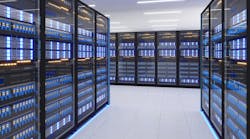How AI's Transformative Impact on Data Centers Is Driving Unprecedented Industry Growth, Innovation, and Global Expansion
Newly released research and market analysis illuminates how, as artificial intelligence (AI) continues its rapid expansion across industries, the data center sector is engaged in a step-change evolution to meet its growing demands. JLL’s 2025 Global Data Center Outlook in many ways sets the stage for understanding how AI is reshaping the market, highlighting unprecedented demand, rising infrastructure challenges, and the need for innovative sustainability solutions. The latest findings from Dell’Oro Group reinforce the viability of these trends. Meanwhile, London-based global property consultancy Knight Frank’s recent forecast provides a comparative view of growth and obstacles in EMEA markets.
The AI-Driven Surge in Data Center Demand
JLL’s research predicts that an estimated 10 gigawatts (GW) of new data center capacity will break ground globally in 2025, with 7 GW expected to reach completion. This growth reflects a baseline compound annual growth rate (CAGR) of 15% through 2027, with a potential to reach 20%.
However, JLL notes that rapid expansion presents challenges, including supply-demand imbalances and electricity transmission constraints in key global markets.
“The pace of AI innovation is not slowing down, and the data center industry must continue to adapt,” said Jonathan Kinsey, JLL’s EMEA Lead and Global Chair, Data Centre Solutions. “AI’s transformative power demands have already reshaped our world, yet its most significant and enduring effect may lie in how we rise to meet the substantial energy demands required to fuel this technological revolution.”
JLL’s findings underscore the impact of AI on data center infrastructure, with next-generation workloads requiring higher power densities and advanced cooling solutions. The analysis notes that current rack densities range from 40 kW to 130 kW per rack, and future chips could push this figure to an astounding 250 kW per rack. The increasing heat generated by high-performance GPUs makes liquid cooling essential, with immersion cooling forecast to become a common standard as AI adoption accelerates.
While AI-driven workloads are a significant factor in future growth, JLL estimates that traditional workloads—such as data storage and cloud applications—will still represent the majority of data center demand by 2030. Nonetheless, the research emphasizes how AI is reshaping data center operations, with predictive maintenance optimizing energy efficiency and reducing downtime.
Addressing Power Constraints and Sustainability Challenges
JLL anticipates that global data center energy consumption could double over the next five years. Despite this, data centers will account for only about 2% of global electricity usage in 2025. Power availability remains a critical bottleneck, particularly in major data center hubs like Northern Virginia, Tokyo, and London, where high-density clusters face transmission delays.
“Data center developers evaluate markets based on power, land, connectivity, and tax incentives,” said Andy Cvengros, JLL Co-Lead U.S. Data Center Markets. “Scarcity is only half of the power story; transmission is the other part. The time required to build transmission lines and substations to connect new data centers to the grid can extend beyond four years in some locations.”
Amidst these challenges, JLL notes how alternative energy solutions are gaining traction. Large-scale nuclear power is emerging as a preferred option for AI and high-performance computing applications, with small modular reactors (SMRs) offering a potential long-term solution. While commercial SMR deployment in the U.S. is unlikely before 2030, JLL expects significant announcements in this space in 2025.
JLL’s 2025 Global Data Center Outlook: Deep Dive on 5 Key Trends
JLL's latest global analysis thus advances the contention that the data center industry is entering an unprecedented transformative phase, propelled by the rapid expansion of AI.
The increasing demand for AI-powered applications has led to record-breaking levels of global data center construction. Advances in semiconductor technology are significantly enhancing processing speeds, enabling larger AI models and further driving infrastructure needs. With each new generation of GPUs, the pace of AI innovation accelerates, ensuring continued demand for high-performance data center solutions.
The new JLL report discerns 5 key trends driving the industry in 2025. They are distilled here as follows.
1. Power Infrastructure Bottlenecks
The expansion of data centers is being constrained by power transmission challenges. While power availability garners attention, the extended timelines required to build transmission lines present a more immediate concern. In many regions, securing regulatory approvals and easements can take over four years, delaying new developments. As a result, site selection criteria are shifting, with developers prioritizing locations based on power availability rather than traditional factors like cost and land size. Utilities are also tightening access to Purchase Power Agreements (PPAs), filtering out speculative projects to focus resources on viable developments.
2. The Rise of Nuclear Power and SMRs
Nuclear energy is emerging as a preferred solution to meet the rising energy demands of data centers, particularly for AI and high-performance computing. Major tech companies, driven by aggressive net-zero targets, are turning to nuclear power as a clean and stable energy source. While large-scale nuclear projects remain limited, SMRs and microreactors are gaining interest. SMRs, offering scalable power solutions from 1.5 to 300 megawatts, could transform data center energy strategies if they become commercially viable by 2030. The success of SMRs could significantly impact site selection, facility design, and long-term operational strategies.
3. The Shift to Liquid Cooling
With AI chips consuming up to 300% more power than previous generations, traditional cooling methods are becoming inadequate. Liquid cooling is now a necessity for high-density workloads, with hybrid cooling solutions—combining liquid and air cooling—becoming the norm. New data centers are increasingly designed with liquid cooling infrastructure, while existing facilities are upgrading to rear-door heat exchangers (RDHx) and direct-to-chip (DTC) technologies. Immersion cooling, while still in its early stages, is poised to become a mainstream solution as rack densities continue to rise. However, structural challenges, such as reinforced flooring for heavy cooling baths, must be addressed for large-scale adoption.
4. Data Center Investment Landscape
The financial outlook for data centers in 2025 is strong, with an estimated $170 billion in asset value requiring development or permanent financing. JLL Capital Markets highlights how while investment transaction volumes are expected to increase only moderately, development financing presents a significant opportunity. Large-scale projects continue to attract institutional capital, though bid-ask spreads and interest rate fluctuations remain challenges. JLL notes that the majority of development financing is structured at 65% to 80% loan-to-cost, while permanent financing is arranged at 65% to 75% loan-to-value. Meanwhile, as the deals grow larger, JLL notes that club deals are becoming more common, with an increasing number of lenders entering the market.
5. Market Trends and Asset Trading
Despite significant investor interest, JLL anticipates that global data center trading volume will see only modest growth in 2025. Historical data shows that global data center investment sales (excluding entity trades and recaps) have averaged just $7 billion annually since 2020—significantly lower than the $241 billion average for office assets. Many developers will seek to exit positions and recycle capital, but bid-ask spreads and financing conditions may pose challenges. JLL expects that most owners will hold onto assets, waiting for improved financial conditions before selling.
Looking Ahead
As data centers evolve to support the next generation of AI and high-performance computing, JLL's latest report concludes that the industry faces both significant opportunities and challenges.
Rising energy demands, technological advancements, and investment shifts are reshaping the sector. The convergence of these factors presents a generational opportunity for innovation, sustainability, and growth. Successfully navigating this landscape will require strategic planning, technological adaptation, and a focus on long-term energy solutions.
JLL said it remains committed to guiding investors and operators through these dynamic market conditions.
Dell’Oro Analysis Supports Findings on AI Data Center Growth Trends
Supporting JLL’s projections, Dell’Oro Group has raised its forecast for data center liquid cooling and rack power distribution, now predicting a 14% CAGR through 2029, reaching $61 billion.
According to Tam Dell’Oro, Founder of Dell’Oro Group, demand for accelerated computing and AI-specific workloads is exceeding expectations, expanding from Tier 1 to Tier 2 cloud service providers.
“The proliferation of accelerated computing to support AI and machine learning workloads has emerged as a major driver in the data center physical infrastructure market,” said Dell’Oro.
“AI workloads require significantly higher power densities, with rack power needs rising from an average of 15 kW today to between 60 kW and 120 kW in the near future. This shift is accelerating the industry-wide transition from air to liquid cooling.”
Dell’Oro’s report highlights strong growth in data center infrastructure investment in North America, EMEA, and Asia-Pacific, with colocation facilities playing an increasing role in AI deployment.
While the top 10 cloud providers continue building purpose-built AI facilities, the report emphasizes how colocation providers are expected to take on a greater share of AI inferencing workloads over time.
EMEA Data Center Market Dynamics Reflect Growth and Constraints
For its part, London-based Knight Frank’s Global Data Centres Forecast 2025 paints a picture of robust industry expansion in EMEA, driven by AI, cloud adoption, and hyperscale development. Live IT capacity in the region is expected to grow from 10,280 megawatts (MW) in 2024 to 12,471 MW in 2025, reaching 14,810 MW by 2026.
According to the analysis, hyperscale providers such as Microsoft, Amazon Web Services, and Google continue to dominate, but increasing power constraints and regulatory challenges are forcing a strategic shift toward emerging secondary markets.
“Data center demand in Europe continues to surge, with growth in FLAP-D markets complemented by expansions in Tier 2 and Tier 3 locations,” said Oliver Weston, EMEA Data Centre – Development & Investment at Knight Frank. “Operators are seeking new locations with viable land and power availability to balance growing regulatory scrutiny.”
While FLAP-D (Frankfurt, London, Amsterdam, Paris, and Dublin) remains central, the research notes how developers are targeting alternative markets such as Lille, Dusseldorf, Turin, Lisbon, and Bilbao, where land costs are lower and grid constraints are less severe.
However, power shortages remain a critical issue across Europe, prompting developers to explore private wire agreements, gas turbine generation, and renewable energy partnerships to mitigate grid limitations.
“The intersection of AI, sustainability, and power constraints is reshaping the data center sector,” said Stephen Beard, Global Head of Data Centres at Knight Frank. “Investors and developers must navigate increasingly complex environmental and regulatory landscapes to ensure continued expansion.”
The Compelling Future of AI and Data Center Growth
As demonstrated above, the global data center sector is definitely on an unprecedented growth trajectory, fueled by AI-driven computing demands and evolving infrastructure needs.
JLL’s forecast underscores the industry’s rapid expansion and the increasing challenges tied to power availability and sustainability. Dell’Oro Group’s findings validate these trends, demonstrating that AI is pushing the industry toward higher-density, more exclusively liquid-cooled environments. Meanwhile, Knight Frank’s EMEA insights highlight how regional power constraints and regulatory complexities are shaping investment strategies.
Despite these hurdles, the outlook for the data center industry remains highly compelling. As AI adoption accelerates, the sector must continue to innovate, integrating alternative energy solutions, enhancing efficiency, and expanding into new markets. Those who successfully navigate these changes will stand to capitalize most on the next wave of digital infrastructure evolution.
What Skyrocketing AI and Hyperscale Infrastructure Investment Means for Data Centers
To conclude, Google’s announcement this week of $75 billion in AI-related CapEx for 2025 only underscores the hyperscale sector’s unrelenting investment in AI infrastructure. This follows similar announced commitments from Microsoft ($80B), Amazon (at least $75B), Meta ($60–65B), and the Stargate Project ($100B annually for four years), bringing projected 2025 AI infrastructure spending to nearly $400 billion.
For data center operators and investors, this all signals several key points about the present industry, including its:
- Unprecedented Scale – AI infrastructure requirements now demand developments on the scale of entire cities. Meta’s Louisiana campus will support 2GW—comparable to the size of a significant portion of Manhattan, as noted recently by company founder Mark Zuckerberg.
- Market Acceleration – CapEx expansion at this level fuels land acquisitions, power procurement, and new development models, particularly in high-power-density designs.
- Strategic Adaptation – As AI demand reshapes data center economics, operators must rethink site selection, energy sourcing (including nuclear and natural gas), and modular deployment strategies.
The data center industry has evolved in scale from IT closets to comparators including Wal-Mart-sized facilities, then aircraft carriers, and now Manhattan-scale developments. In the AI era, the next industry frontier is apparently headed toward $500 billion in megacampuses - just for starters.
The question for data center operators and stakeholders is: Are your infrastructure strategies evolving fast enough?
At Data Center Frontier, we not only talk the industry talk, we walk the industry walk. In that spirit, DCF Staff members may occasionally employ AI tools to assist with editorial content. This article was created with help from Open AI's GPT-4.
Keep pace with the fast-moving world of data centers and cloud computing by connecting with Data Center Frontier on LinkedIn, following us on X/Twitter and Facebook, and signing up for our weekly newsletters using the form below.
About the Author
Matt Vincent
A B2B technology journalist and editor with more than two decades of experience, Matt Vincent is Editor in Chief of Data Center Frontier.



